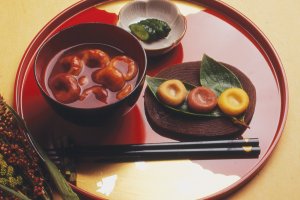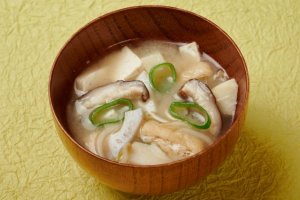Japanese cuisine offers a wide range of delicious food options beyond the popular Kanto and Kansai regions.
There are hidden culinary treasures in other areas like Tohoku, Chugoku, Shikoku, and Kyushu. Delving deeper into Japan's culinary landscape unveils a profound commitment to food that transcends seasons, regions, and communities, giving rise to a rich tapestry of distinctive local flavors.
The website "Our Regional Cuisines" provides detailed information about the history, origin, and recipes of 1,365 regional cuisines—including fried foods, tempura, poultry, seafood, soups, desserts, and more—in English, allowing visitors to explore little-known local cuisines in Japan.
Tohoku
1. Damako Nabe from Akita

Damako Nabe is a local cuisine of Akita Prefecture and originated in the Nanshu region around Hachirogata. Originally known as tsukego, it features grilled fish from Hachiro Lagoon, seasoned with miso. However, with the lagoon's reclamation and a decline in fish catch, Damako Nabe transformed, incorporating locally-bred Hinai Jidori chicken, green onion, Japanese parsley, maitake mushroom, and burdock root into a comforting chicken stew. It is still a popular local dish that is eaten in every household in Akita Prefecture in winter. In Akita Prefecture, there is a tradition known as Niwa-arai that involves cooking freshly harvested rice, mashing it, and forming dumplings, which are then enjoyed as damako dumplings.
2. Hechoko Dango from Iwate

Hechoko Dango, or Uki Uki Dango are dumplings made with millet flour served in warm red bean soup. It is a traditional dish from Iwate Prefecture, crafted from millets such as sorghum flour, glutinous millet flour, and sticky millet flour. The dango is served in a warm and sweet red bean soup, where the slightly bitter taste of sorghum flour complements the sweetness of the soup. The term Hechoko expresses gratitude for the farmers' hard work throughout the year, and the dent in the center of dango is said to resemble a person's belly button. This traditional dish, often enjoyed at the end of autumn after the harvest, not only serves as a delectable treat but also as an offering to the gods.
3. Shiobiki Zushi from Yamagata

Shiobiki Zushi, a type of pressed sushi, finds its origins in Yonezawa City, located in Yamagata Prefecture. This unique sushi variety is crafted from salted salmon. Yonezawa City, surrounded by mountains and historically limited in access to fresh seafood, relied on freshwater fish like carp, river fish, and preserved options such as cod, herring, and salted salmon. Thus, Shiobiki Zushi became a symbol of celebration due to its vibrant red and white appearance, and it continues to be a favored dish for special occasions. Traditionally, wooden crates were employed for the meticulous preparation of pressed sushi, but modern methods sometimes involve the use of large molds for efficient cutting.
Chugoku
4. Takomeshi from Okayama

Takomeshi is a flavorful rice dish from Okayama Prefecture featuring octopus and onions. The octopus, sourced from Kurashiki in Okayama, is renowned for its distinctive chewiness and deliciously firm meat. Born from the tradition of fishermen enjoying freshly caught octopuses on their boats, Takomeshi has evolved into a versatile dish found both on family dining tables and restaurant menus. Although the name succinctly captures the essence of the dish, Takomeshi exhibits diverse characteristics, with variations in ingredients, seasonings, and toppings varying across different establishments. Okayama, boasting one of the country's largest octopus catches, takes pride in delivering a dish that showcases the delectable qualities of its locally sourced octopus.
5. Fugu no Karaage from Yamaguchi

Fugu no Karaage, a fried pufferfish dish, is a specialty of Yamaguchi Prefecture, renowned for its expertise in preparing fugu dishes. Pufferfish, known for its poisonous ovaries and livers, requires licensed professionals to handle its preparation in each prefecture. Yamaguchi, with its abundant fishing grounds, has a longstanding tradition of skillfully preparing and enjoying fugu. The green rough-backed pufferfish is the star of homemade or restaurant-served Fugu no Karaage. The fugu filets are seasoned, and deep-fried to a crispy perfection, creating a delightful contrast with the tender texture of the fish, showcasing the culinary artistry surrounding the preparation of fugu in Yamaguchi.
Shikoku
6. Misoshiru from Ehime

Ehime Prefecture's barley miso soup stands out as a distinctive local variant of the widely cherished miso in Japan. Barley miso, produced in the Setouchi area, Ehime and Yamaguchi prefectures, and throughout Kyushu, is created by combining soybeans with barley malt and salt, though its ingredients vary among households. Ehime's barley miso is renowned for its gentle aroma and refined sweetness, attributed to its elevated malt content from abundant barley use. Beyond its appealing taste, barley miso is rich in dietary fiber and protein, potentially contributing to cholesterol control and different health benefits. This nutritious misoshiru or miso soup, a household staple in Ehime, is not only easy to prepare but also features in various dishes, including local specialties, making barley miso a versatile and health-conscious ingredient year-round.
7. Kokera-Zushi from Kochi

Kokera-Zushi is a type of sushi in which vinegared rice and ingredients such as eggs, carrots, shiitake, fish are meticulously layered within a square wooden frame like a cake. The layers of ingredients symbolize "Piling up joy," and the dish has been cherished for generations as a symbol of good luck. As an integral aspect of Kochi prefecture's sushi culture, Kokera-Zushi holds historical significance, dating back approximately 130 years. In times when rice was a precious commodity, sushi represented the pinnacle of feasts, reserved for special occasions like weddings, funerals, celebratory events, and 60th birthday celebrations (Kanreki). The primary purpose of Kokera-Zushi is to provide a fulfilling and auspicious rice-based meal for celebratory moments and rituals.
Kyushu
8. Tori-Ten from Oita

Tori-Ten is a deep-fried chicken in Tempura Flour, widely popular throughout Oita Prefecture. Enjoyed regularly by locals, it has become a common offering in restaurants catering to both residents and tourists. Originating from the prefecture's first restaurant, Toyoken in Beppu City, Tori-Ten emerged in response to the challenges posed by bone-in fried chicken during the early Showa period. To address this, boneless chicken thighs were cut into bite-sized pieces and prepared in a Tempura style, featuring a thick batter that increased the chicken quantity, making it accessible for larger families. The quick-cooking and delightful combination of crispy and tender textures contributed to the dish's popularity, leading to its widespread availability in various restaurants.
9. Chicken Nanban from Miyazaki

Chicken Nanban, now a popular dish throughout Japan, has its origins in Nobeoka City, Miyazaki Prefecture. Widely enjoyed as an everyday meal at home, in restaurants, and even as a school lunch, Chicken Nanban is a culinary delight with a historical twist. The term Nanban in Chicken Nanban originally referred to the Portuguese who arrived in Japan during the Warring States Period, bringing with them their culture, including a dish called nanbanzuke. This dish involved marinating ingredients in sweet vinegar with chili peppers. Over time, this preparation method came to be associated with chicken, giving rise to the name "Chicken Nanban." The dish typically features fried chicken served with either tartar sauce or a sweet and sour sauce, creating a flavorful and popular addition to Japanese cuisine.
10. Ganeage (Fried sweet potato) from Kumamoto

Ganeage, a delightful treat, traces its origins to the Amakusa area in Kumamoto Prefecture. This unique dish emerged as a vegetarian alternative for Buddhist ceremonies, where the use of fish was restricted. Instead, thick slices of sweet potatoes were deep-fried in rapeseed oil, resulting in the creation of Ganeage. The batter is seasoned with a blend of chopped or shredded ginger and sweetened with sugar, contributing to its crispy texture and flavorful profile. Originally conceived as a vegetarian option, Ganeage has evolved into a versatile dish enjoyed at various events such as weddings, funerals, and ceremonial occasions. Embraced by individuals of all ages, this crunchy delight has become a popular choice not only as a snack but also as a regular part of everyday meals.
For your next Japan trip
Japan boasts a diverse culinary landscape with a rich tapestry of regional foods waiting to be explored. While many people are familiar with the well-known Kanto and Kansai area, several lesser-explored regions like Tohoku, Chugoku, Shikoku, and Kyushu also offer hidden gems of local cuisine. The 'Our Regional Cuisines' website is an excellent resource to discover these culinary treasures. The website meticulously introduces each dish, delving into its details and passionately preserving and promoting its traditions. By showcasing the greatness of these lesser-known culinary traditions from all over Japan, the website not only enhances the appreciation of Japan's food culture but also encourages visitors to explore the country's culinary richness further. Our Regional Cuisines invites everyone to savor the unique flavors found in every corner of Japan!































